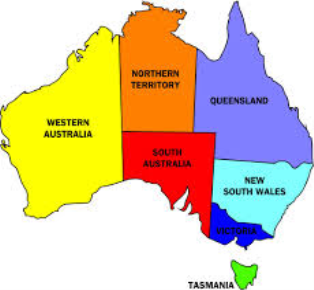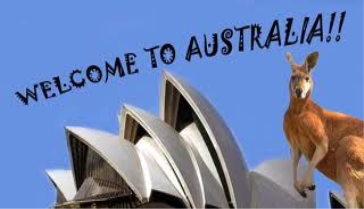The Commonwealth of Australia
Lesson 1
The Commonwealth of Australia
Aims:
- to teach students to respect the culture of foreign country;
- to teach students to take responsibility for their own learning;
- to teach students to think in detail about what they have learnt;
- to introduce and practice the vocabulary;
- to widen the students’ outlook;
- to develop interactive skills based on the country study.
Materials: multimedia complex, cards with tasks, map of Australia, tape-recorder, CD record of the text.
PROCEDURE
- Warm-up
The song of Australia by Mrs. C. J. Carleton
There is a land where summer skies
Are gleaming with a thousand dyes,
Blending in witching harmonies ;
And grassy knoll and forest height,
Are flushing in the rosy light,
And all above is azure bright — Australia!
There is a land where honey flows,
Where laughing corn luxuriant grows,
Land of the myrtle and the rose ;
On hill and plain the clust'ring vine
Is gushing out with purple wine,
And cups are quaffed to thee and thine — Australia!
There is a land where treasures shine
Deep in the dark unfathom'd mine
For worshippers at Mammon's shrine;
Where gold lies hid, and rubies gleam,
And fabled wealth no more doth seem
The idle fancy of a dream — Australia!
There is a land where homesteads peep
From sunny plain and woodland steep,
And love and joy bright vigils keep ;
Where the glad voice of childish glee
Is mingling with the melody
Of nature's hidden minstrelsy — Australia!
There is a land where, floating free,
From mountain-top to girdling sea,
A proud flag waves exultingly ;
And FREEDOM'S sons the banner bear,
No shackled slave can breathe the air,
Fairest of Britain's daughters fair — Australia!
This poem is published in The South Australian Register
 on 21 October 1859.
on 21 October 1859.
Dear friends! Our theme is devoted to one of the greatest states in the world.
We are going to talk about Australia, it’s history, political system, geography, industry, agri-culture, holidays, cities, ways of life, culture, hobbies of the Australian people. I hope you will learn many interesting things during this theme.
- Reading
Before you read
Practice the new vocabulary.
New words to know:
- subsequent – наступний
- indigene – тубілець
- income – дохід
- expenditure – поглинання. споживання
- maintain – підтримувати, зберігати
Read the text
The Commonwealth of Australia
Australia officially the Common-wealth of Australia, is a country comprising the mainland of the Australian continent, the island of Tasmania, and numerous smaller islands. It is the world's sixth-largest country by total area. Neighbouring countries include Indonesia, East Timor and Papua New Guinea to the north; the Solomon Islands, Vanuatu and New Caledonia to the north-east; and  New Zealand to the south-east.
New Zealand to the south-east.
For at least 40,000 years before the first British settlement in the late 18th century, Austra-lia was inhabited by indigenous Australians, who spoke languages grouped into roughly 250 language groups. After the discovery of the continent by Dutch explorers in 1606, Australia's eastern half was claimed by Great Britain in 1770 and settled through penal transportation to the colony of New South Wales from 26 January 1788. The population grew steadily in subsequent decades; the continent was explored and an additional five self-governing Crown Colonies were established.
On 1 January 1901, the six colonies federated, forming the Commonwealth of Australia. Since Federation, Australia has maintained a stable liberal democratic political system that functions as a federal parliamentary democracy and constitutional monarchy. The federation comprises six states and several territories. The population of 23.1 million is highly urbanized and heavily concentrated in the eastern states.
Australia is a developed country and one of the wealthiest in the world, with the world's 12th-largest economy. In 2012 Australia had the world's fifth-highest income per person, Australia's military expenditure is the world's 13th-largest. With the second-highest human development index globally, Australia ranks highly in many international comparisons of national performance, such as quality of life, health, education, economic freedom, and the protection of civil liberties and political rights. Australia is a member of the United Nations, G20, Commonwealth of Nations, ANZUS, Organization for Economic Cooperation and Development (OECD), World Trade Organization, Asia-Pacific Economic Cooperation, and the Pacific Islands Forum.
3. Understanding the texts.
1. What is the official name of Australia?
2. When was this continent discovered by Dutch explorers?
3. When was the Commonwealth of Australia formed?
4. What are Australia’s native people called?
5. How many people live in Australia?
6. How many States and Territories does Australia have?
4. Agree or disagree with the statements. Give your reasons.
1. Australia is the world's sixth-largest country by total area.
2. For at least 20,000 years before the first British settlement in
the late 18th century, Australia was inhabited by indigenous Australians.
3. On 1 January 1901, the ten colonies federated, forming the Commonwealth of Australia.
4. The population of 23.1 million is highly urbanized and heavily concentrated in the eastern states.
5. Australia is a developed country and one of the wealthiest in the world, with the world's 13th-largest economy.
6. In 2012 Australia had the world's fifth-highest income per person, Australia's military expenditure is the world's 11th-largest.
- Listening.
Listen to the text and do the tasks which follow.
Australia
Australia is a large country lying between the Indian and Pacific Oceans. Australia is an island, like Britain, but unlike Britain, it is vast. It is, in fact, nearly twenty-five times as large as the British Isles. Its area is about 8,000,000 square km. The population of Australia is about 18 mln. Most of Australia is semi-desert. People cannot live where there is no water, and so most of people in Australia live in the richer south-east. The first Australian people were dark-skinned Aborigines, and though the coming of the white settlers destroyed their tribal lives, some sixty thousand still survive in Australia today. Their account for about 1 percent of the population. They may be found in the island areas of the country. Some live in modern cities but it is not really easy for them. They have to fight for their rights. The first Europeans to land in this country were Dutch sailors. The national holiday, Australia Day, is now celebrated on or near January 26th in memory of landing of the British in 1788. The young country grew very fast. Today Australia is an independent federative state consisting of 6 states and 2 territories. It is a member of the Commonwealth headed by the British Queen. The national language is English. The capital of Australia is Canberra; the largest cities are Sidney, Melbourne, Adelaide and Perth.
6. Check it
Fill in the missing words.
|
Australia Day, member , sailors, dark-skinned, large, population |
- Australia is a … country lying between the Indian and Pacific Oceans.
- The … of Australia is about 18 mln.
- The first Australian people were … Aborigines.
- The first Europeans to land in this country were Dutch … .
- The national holiday, … , is now celebrated on or near January 26th in memory of landing of the British in 1788.
- Australia is a … of the Commonwealth headed by the British Queen.
7. Say it
(Pair-work) Explain in English these words from the text:
island
population
aborigines
settlers
independent federative state
8. Reading and speaking
Group discussion.
The students read and discuss the key facts about Australia.
Key facts
More than 6.5 million migrants have settled in Australia since 1945. English is the national language but other languages are valued.
Australia is predominantly Christian but people are free to practice any religion they choose.
Around 88 per cent of Australians go to at least one cultural event each year. More than 11 million Australians aged 15 or over take part in sport or other physical activity.
Australia has one of the most diverse cuisines in the world but has no national dish.
9. Homework
Look at the key facts about Australia, choose one of them and write down what you already know about it.
Use reference books, the Internet and find out more about it. Share the information with the rest of the class.
-
Thank you!


про публікацію авторської розробки
Додати розробку
